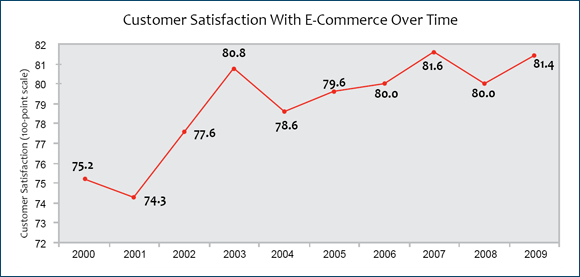Just a couple of hours ago, ForeSee Results has released the results of the newest ACSI Annual E-commerce study.
After a slight drop in 2008, the overall customer satisfaction with e-commerce sector has raised in 2009 back to the level of 2007. The drop in 2008, just as drops in 2001 and 2004, are explained as fluctuations that naturally “follow the normal recessions and contractions of the economic cycle”, and “when examined from a bird’s eye view”, they “illustrate the progressive competence of the market as a whole.” Here’s that bird’s eye view chart:

This year marks the 10th anniversary of the inclusion of e-commerce companies in this well-known economic benchmark, and I thought my readers may find the 10-year history of company scores of interest. So, here they are:
|
|
2000 |
2001 |
2002 |
2003 |
2004 |
2005 |
2006 |
2007 |
2008 |
2009 |
% |
% |
|
Retail |
78 |
77 |
83 |
84 |
80 |
81 |
83 |
83 |
82 |
83 |
1.2% |
6.4% |
|
Netflix |
NM |
NM |
NM |
NM |
NM |
NM |
NM |
84 |
85 |
87 |
2.4% |
3.6% |
|
Newegg |
NM |
NM |
NM |
NM |
NM |
NM |
NM |
87 |
88 |
86 |
-2.3% |
-1.1% |
|
Amazon.com |
84 |
84 |
88 |
88 |
84 |
87 |
87 |
88 |
86 |
86 |
0.0% |
2.4% |
|
All Others |
77 |
75 |
82 |
83 |
79 |
80 |
82 |
82 |
82 |
83 |
1.2% |
7.8% |
|
Overstock.com |
NM |
NM |
NM |
NM |
NM |
NM |
NM |
80 |
82 |
82 |
0.0% |
2.5% |
|
eBay |
80 |
82 |
82 |
84 |
80 |
81 |
80 |
81 |
78 |
79 |
1.3% |
-1.3% |
You may receive your copy of this brief (only 8 pages long), but interesting report here.
Anticipating possible confusion between the above-quoted study and the one I’ve quoted here, let me clarify. The holiday data I wrote about in December 2009 comes from a different research: data collected through FGI Research’s SmartPanel™, a nationwide panel of approximately 1.6 million consumer households who have agreed to participate in opt-in surveys. The ACSI Annual E-commerce Report, on the other hand, comes from the ACSI — the American Customer Satisfaction Index, founded at the University of Michigan.
Not sure I can accept the idea that satisfaction with ecommerce drops as a result of a fluctuation in an economic cycle – volumes perhaps but not satisfaction. It looks like there is another cycle at work and my suggestion is that ecommerce sites are slow to respond to the changing demands of their customers and constantly playing catch up in the face of growing expectations. Which is slightly more serious.
I have been thinking about that explanation ever since I’ve read and re-posted it, Mark; so it’s good to have you chime in.
You suggest “that ecommerce sites are slow to respond to the changing demands of their customers”. I’ve actually been noticing quite the contrary (especially with bigger e-tailers like Amazon, Overstock, etc). Here’s just one example I’ve blogged about: Who Made Black Friday Deals Available on Thursday.
If you have examples to illustrate your point, I’d love to read then.